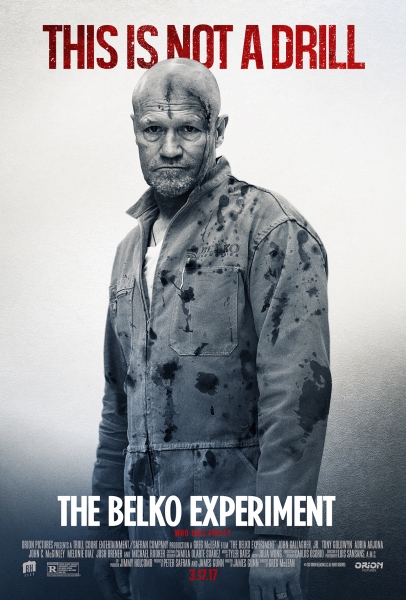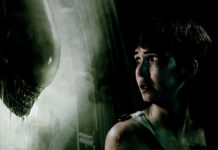I don’t know if it was the fact I saw this movie at 11:30 at night or just the nature of the film itself, but whatever the reason one thing became painfully clear…people can have unsettling reactions to certain content. Typically when I describe movies to people, I often describe them as a sort of mixing of two other films to explain the overall feel and look of the film. With “The Belko Experiment”, the poster says it all: this really is a mixing of “Office Space” and the Japanese shock/gore fest “Battle Royale.” This is a strange, bizarre, bloody movie that seemed to come out of nowhere and I think a lot of people (myself included) didn’t really know what to make of it. But my showing was almost sold out so obviously other people were as morbidly curious as I was about this.
In Bogota, Columbia, 80 average American workers go about their daily lives at their office jobs at the “Belko company” building. Things turn dark when metallic shields come down and lock all 80 employees inside the building, cutting off cell phone signals and any chance of escaping. The employees are ordered by a voice over their intercom to kill their co-workers by any means necessary in a timely manner if not, the employees will be killed themselves via explosive tag chips that were implanted in the back of every employee’s head. Now everyone’s co-workers, managers and cubicle neighbors have to kill or be killed themselves. To be perfectly blunt, “Belko Experiment” isn’t really anything new. This whole “kill or be killed” perspective has been done many, many times before; the only real difference here is the office setting.
Still, as the “experiment” continues, the film manages to keep the premise interesting enough by elevating the threats and the possibilities for people to break down their civil mentalities and turn into mass murderers. One particular sequence was Tony Goldwyn’s character trying to make a “reasonable system” for who should die and who should live, only to find out it’s not enough and quickly dissolving into a darker side than you first expected. There are no real surprises at who becomes trigger happy and who stays reasonable. Never the less, when the characters are routinely faced with the threat of their brains being blasted out the back of their heads is presented, it doesn’t make their horrifying actions any less shocking.
Some people’s deaths you can see coming a mile away, others prove to be quite surprising and thankfully the movie treats these people’s deaths as something to be mortified over and NOT something to joke about. The writer of this film, James Gunn (Guardians of the Galaxy, Slither) has been well versed at blending gruesome gore with black comedy before, but the little comedy that is included in here doesn’t demean or delude the severity of these killings. The cast is half good, half forgettable. I personally want to give extra applause to John Gallagher Jr., Sean Gunn, Tony Goldwyn and Adria Arjona for their excellent performances. Though some ignorant crowd members next to me seemed to find the character’s actions comical, I felt the majority of the characters reactions to be quite natural in this kind of situation.
The most unnatural element was actually the driving point of the story’s conflict: the explosive tags. Even with the suspension of disbelief riding high, it’s hard to genuinely believe anyone would allow ANY company implant chips into their heads; no excuse can sell that. “Belko Experiment” misses the mark by quite a bit when it comes to making us care about these partially developed characters. The film kicks it’s murder machine into full gear about 15 minutes into the film. I personally think if another 30 minutes had been added to the film’s running time; focused squarely on developing these individuals past their one-note personalities, you’d feel just a bit more about watching them get brutally slaughtered…not enough as I did when I saw “Battle Royale” but enough that it would have made the deaths more impactful.
Overall, “The Belko Experiment” rides on the blood-soaked coattails of humanity’s worse aspects to do most of its own writing. We got some enjoyable performances from select players, but the rest of the token characters are just that: tokens with hardly any depth or development to make you care if they’re cleared off the board or not. Still, it leaves you with an interesting ending and certainly will never bore you at any point in the film. “The Belko Experiment” has mixed results at best, which is too bad because with a few more tweaks and additions here and there, this could have been a smashing success.
I give “The Belko Experiment” 2 stars out of 4.




